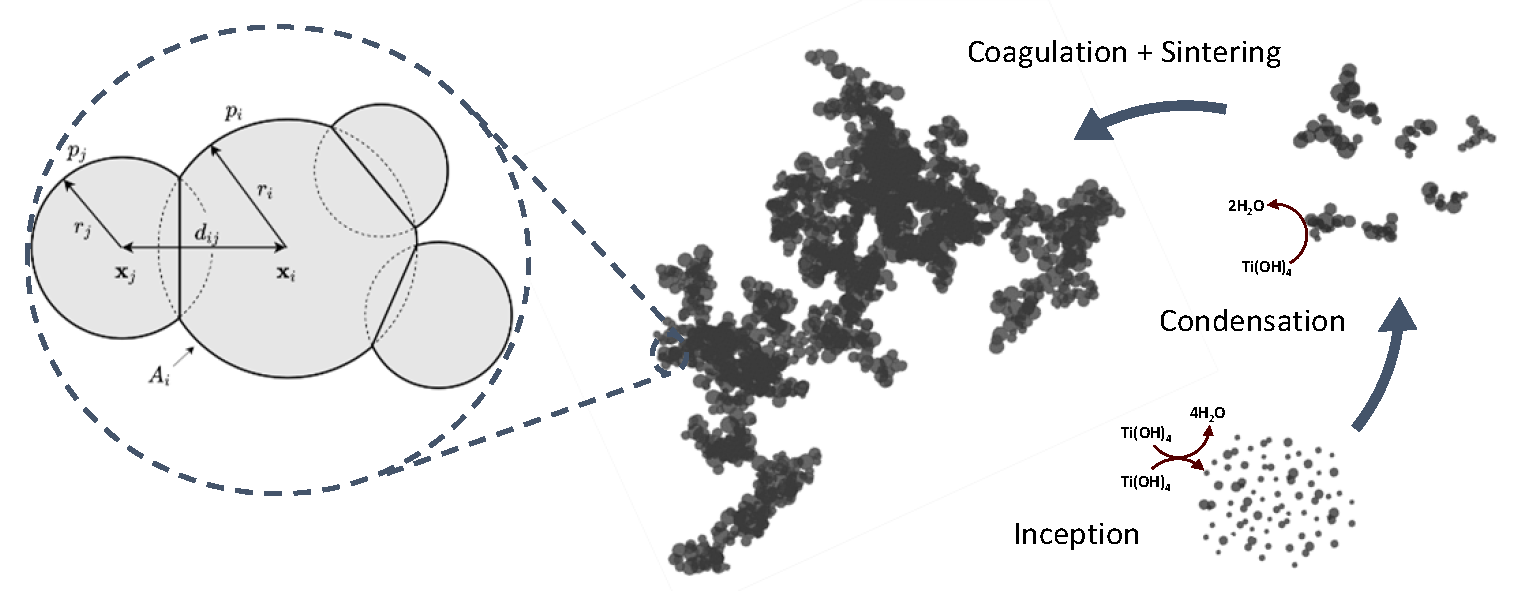Technical Report 215, c4e-Preprint Series, Cambridge
A detailed particle model for polydisperse titanium dioxide aggregates
Reference: Technical Report 215, c4e-Preprint Series, Cambridge, 2018
- New multivariate PBM with detailed morphological description of titania aggregates.
- Overlapping spheres model of aggregates, resolving position of individual primaries.
- Particles evolve under inception, condensation, coagulation and sintering.
- Convergence behaviour investigated for a batch reactor test case.
- Experimental hot-wall reactor simulated.
 The mathematical description of a new detailed particle model for polydisperse titanium dioxide aggregates is presented. An aggregate particle is represented as a collection of overlapping spherical primary particles and the model resolves the composition, radius and position coordinates of each individual primary to form a detailed geometrical description of aggregate morphology. The particle population evolves under inception, coagulation, condensation, sintering and coalescence processes. The detailed particle population balance model is coupled to detailed gas-phase chemistry using operator splitting. Titanium dioxide particles are formed through collision limited inception and condensation reactions of Ti(OH)4 from the gas-phase, produced from the thermal decomposition of titanium tetraisopropoxide (TTIP) precursor. A numerical study is performed by simulating a simple batch reactor test case to investigate the convergence behaviour of a number of functionals with respect to the maximum number of computational particles and splitting time step. A lab-scale hot wall reactor is simulated to briefly demonstrate the advantages of a detailed geometrical description. Simulated particle size distributions were in reasonable agreement with experimental data. Further evaluation of the model and a parametric sensitivity study are suggested.
The mathematical description of a new detailed particle model for polydisperse titanium dioxide aggregates is presented. An aggregate particle is represented as a collection of overlapping spherical primary particles and the model resolves the composition, radius and position coordinates of each individual primary to form a detailed geometrical description of aggregate morphology. The particle population evolves under inception, coagulation, condensation, sintering and coalescence processes. The detailed particle population balance model is coupled to detailed gas-phase chemistry using operator splitting. Titanium dioxide particles are formed through collision limited inception and condensation reactions of Ti(OH)4 from the gas-phase, produced from the thermal decomposition of titanium tetraisopropoxide (TTIP) precursor. A numerical study is performed by simulating a simple batch reactor test case to investigate the convergence behaviour of a number of functionals with respect to the maximum number of computational particles and splitting time step. A lab-scale hot wall reactor is simulated to briefly demonstrate the advantages of a detailed geometrical description. Simulated particle size distributions were in reasonable agreement with experimental data. Further evaluation of the model and a parametric sensitivity study are suggested.
Material from this preprint has been published in Journal of Computational Physics.
PDF (2.5 MB)



